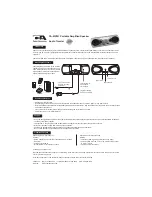
5
fier about 1/4" from the end and insert into the connector input + and - positions and tighten the set
screws. Strip the wire from the woofer and insert into the + and - positions for the crossover woofer
output. Follow the same procedure for the connection to the tweeter. The 6-series passive crossover has
three sets of input terminals, this allows the system to be tri-wired or tri-amplified. If you select to use
one of these wiring schemes you must cut the jumpers in the crossover to electrically separate the high-
pass and low-pass sections (see diagram on page 14 for location of jumpers).
To tri-amplify the system you will need three stereo amplifiers (or six amplifier channels) one for the
tweeters, one formids and one for the woofers.
If you choose to bi-wire the system, connect the high-pass terminals to the amplifier and connect the
low-pass terminals to the same amplifier with another set of speaker wires.
Be sure to connect the positive crossover terminals to the positive speaker terminals and positive ampli-
fier terminals, also ensure that the negative crossover terminals connect to the negative amplifier and
speaker terminals.
Once all of the wires are attached to the connector and the crossover is mounted, the connector can be
plugged into its mating receptacle on the crossover.
speaker wiring
speaker wire selection
Use insulated two-conductor stranded wire to connect the 6-series crossover to the speakers and ampli-
fier. The size of the wire can have an audible effect of the performance of the system. Standard 18
gauge “zip cord” will work, but can result in lower output or unpredictable frequency response. For
wire runs of 50 feet or less, we recommend 16 gauge or larger wire. The crossover connector will accept
up to 14 gauge wire.
polarity and phasing
The polarity - the positive / negative orientation of the connections - for every speaker and amplifier con-
nection must be consistent so all the speakers will be in phase. When the polarity of one connection is
reversed, bass output is reduced and stereo imaging is degraded. All wire is marked so you can identi-
fy the two conductors. There may be ribs or a stripe on the insulation of one conductor. Or the wire
may have clear insulation with different color conductors (copper and silver). Or there may be polarity
indications printed on the insulation. Identify the positive and negative conductors and be consistent
with every speaker and amplifier connection.
plifier to the tweeter to the terminals marked high input. Connect the woofer amplifier to the low
ut terminals with another run of wire.
ortant note - you must cut the jumpers that connect the low frequency and mid frequency sections
he crossover. See diagram 3. Failing to cut these jumpers could cause damage to the amplifiers or
crossover.
diagram 3
amp mid / hi
amp low
Содержание 641is
Страница 2: ......



























